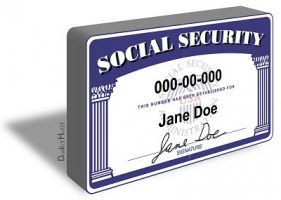Hackers appear to have downloaded all of our SSN-related data from the government’s servers. This is suspicious in an election year, given. that SSNs are – illegally – used by the government to identify us and prove we are who we say we are.
Worse, the SSN is the cornerstone of our identity with banks, mortgage companies, and other financial and medical institutions. With SSNs, criminals can impersonate victims to open new credit accounts, apply for loans, or even commit tax fraud. This can lead to financial losses, damage to credit scores, and the time-consuming process of clearing one’s name.
The recent data breaches involving Social Security numbers (SSNs) pose several significant risks to individuals:
Identity Theft:
- Financial Fraud: Beyond credit fraud, SSNs can be used for banking fraud, where new accounts might be opened, or existing accounts might be accessed for fraudulent activities.
- Medical Identity Theft: SSNs are often used in medical records. A thief could use this information to obtain medical services, leading to incorrect medical records for the victim, which can affect health insurance or future medical treatment.
- Employment Fraud: SSNs are crucial for employment verification. A thief could use someone’s SSN to get a job, which might not only affect the victim’s employment history but also their Social Security benefits in the future.
- Tax Fraud: With an SSN, someone could file fraudulent tax returns to claim refunds or benefits.
Minimizing Risk:
- Monitor Financial Statements: Regularly check bank statements, credit card bills, and credit reports for any unauthorized activity. Services like Credit Karma or official credit report providers can help monitor for new accounts or changes.
- Freeze Your Credit: Placing a credit freeze on your files at the major credit bureaus (Equifax, Experian, and TransUnion) can prevent new accounts from being opened in your name. This might be inconvenient if you need to open new credit, but it’s highly effective in preventing fraud. If you don’t have an. account, go online and make a free account and then opt for the FREEZE option. None of this involves upgrading. to a. paid-for account so have a hunt around the site to find the Freeze Account button.
- Use Strong, Unique Passwords: For any online account linked to your SSN, use strong, unique passwords. Consider using a password manager to generate and store complex passwords.
- Enable Two-Factor Authentication (2FA): Whenever possible, use 2FA with your mobile phone. or email address for your accounts. This adds an extra layer of security beyond just a password.
- Be Wary of Phishing: Educate yourself about phishing scams. Never provide your SSN or other personal information via email or unsolicited calls. Remember, this event may prompt scammers to call to you offer protection against the hack. Don’t fall for that one. Hang up and call your own bank on the number you have off a statement you received in the past.
- Social Security: go to the ssa.gov website and register for online access. You will then get an email or letter mailed to you with any changes or requests on your account.
- Identity Protection Services: Consider subscribing to an identity protection service, which can offer alerts for suspicious activities, credit monitoring, and sometimes even insurance against identity theft. Lifelock is such a service.
- Regularly Check for Data Breaches: Use services like Have I Been Pwned? to check if your information has been part of any data breaches.
- Secure Your Documents: Keep physical copies of your SSN and other sensitive documents in a secure place. Shred documents containing this information before disposing of them.
- Legal Action: If you become a victim, report the identity theft to the Federal Trade Commission (FTC) and your local law enforcement. This can help in your recovery process and might assist in catching the perpetrators.
- Stay Informed: Keep up with news about data breaches. If you’re notified of a breach, act quickly with the steps above.
The key to minimizing risk post-breach is proactive monitoring, securing personal information, and being vigilant against scams. Remember, while these steps can reduce the risk, no method is foolproof, but they significantly increase the difficulty for fraudsters.
